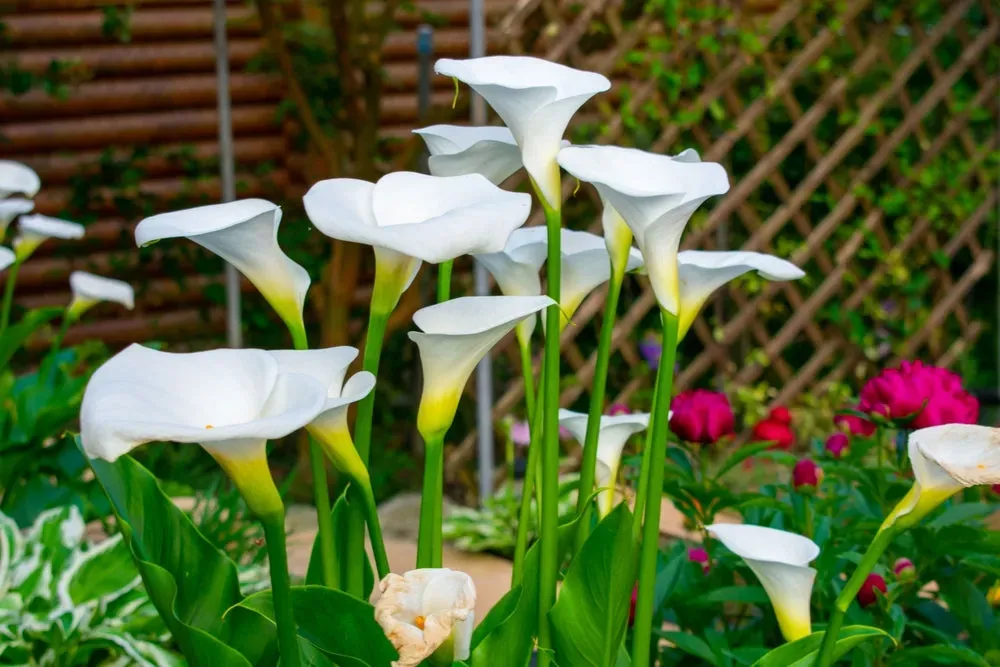Table of Contents
Thinking about adding a splash of vibrant color and graceful height to your garden? Border lilies are a fantastic choice! They're stunning, relatively easy to care for, and offer a wide variety of colors and sizes to suit any garden style. At lilyflower.homes, we're passionate about helping you create the garden of your dreams, and border lilies are a perfect place to start. This article will walk you through everything you need to know, from selecting the perfect lilies for your space to tackling common problems and unleashing your creativity with stunning landscaping designs. Get ready to transform your garden with the captivating beauty of border lilies!

Amazing Border Lilies: A Gardener's Guide
Choosing the Right Border Lilies for Your Garden

Choosing The Right Border Lilies For Your Garden
Understanding Your Garden Conditions
When selecting border lilies for your garden, it's essential to consider the specific conditions of your outdoor space. This includes factors such as sunlight, soil type, and moisture levels. If your garden receives full sun, look for lily varieties that are tolerant of high temperatures and dry spells. On the other hand, if your garden is shaded or has poor drainage, choose lilies that prefer cooler, more moist conditions. Check out our article on Sunlight Needs for Lilies to learn more.
Another critical factor to consider is the soil quality in your garden. Border lilies prefer well-draining, fertile soil that is rich in organic matter. If your soil is heavy clay or sandy, you may need to amend it with compost or other soil conditioners. Our article on Soil Requirements for Lilies provides more information on how to create the ideal soil conditions for your border lilies.
Soil Type | Preferred Conditions |
|---|---|
Clay | Add compost or organic matter to improve drainage |
Sandy | Add compost or organic matter to retain moisture |
Loamy | No amendments needed, ideal for border lilies |
Choosing the Right Variety
With so many beautiful varieties of border lilies to choose from, it can be overwhelming to decide which ones to plant in your garden. Consider the color scheme and style of your garden, as well as the mature height and bloom time of the lilies. If you want to attract pollinators, choose varieties with fragrant flowers. Our article on Flower Color and Meaning provides more information on how to choose the right variety of border lilies for your garden.
- Asiatic lilies: compact, early-blooming, and fragrant
- Oriental lilies: tall, late-blooming, and highly fragrant
- Tiger lilies: vibrant, mid-blooming, and strap-like foliage
Planting and Caring for Your Border Lilies

Planting And Caring For Your Border Lilies
Planting border lilies can be a fun and rewarding experience, especially when you see them grow and bloom into beautiful flowers. Before planting, it's essential to prepare the soil and choose the right location. are crucial, as they need well-draining and fertile soil to grow.
When planting, make sure to dig a hole that is twice as deep and twice as wide as the bulb. Place the bulb in the hole, and cover it with soil. Water the soil well, and keep it consistently moist during the growing season. For more information on watering lilies, check out our article.
- dig a hole twice as deep and twice as wide as the bulb
- place the bulb in the hole
- cover the bulb with soil
- water the soil well
- keep the soil consistently moist
Light and Temperature Requirements
Border lilies have specific light and temperature requirements. Most varieties prefer full sun to partial shade, and temperatures between 60°F to 80°F (15°C to 27°C). Avoid planting in areas with standing water or where water tends to collect. For more information on , check out our article.
Light Requirements | Temperature Requirements | Soil Requirements |
|---|---|---|
Full sun to partial shade | 60°F to 80°F (15°C to 27°C) | Well-draining and fertile |
Lilies are one of the easiest perennials to grow, Transplanting lilies can be done in the spring or fall, when the weather is cool.
Fertilizing and Mulching
Fertilizing and mulching are essential for the growth and blooming of border lilies. Fertilizer for lilies should be applied in the spring, when the plant is actively growing. Mulching helps to retain moisture and suppress weeds. For more information on mulch types, check out our article.
It's also important to note that border lilies need a period of cold winter temperatures to induce blooming. Overwintering tips can help you to prepare your lilies for the winter.
- Apply a thin layer of mulch to retain moisture and suppress weeds
UBLICATION
Border Lilies: Creative Landscaping Ideas
Okay, so you've got your border lilies – fantastic! Now, let's get creative. Think of them not just as pretty flowers, but as building blocks for an amazing garden design. I love using them to create a sense of movement and flow. Imagine a gently curving border, a ribbon of color snaking through your yard. You can plant them in a continuous line, or break it up with other plants for a more textured look. Maybe you could even use them to create a focal point, drawing the eye to a specific area of your garden. Think about the height of the lilies too – taller ones at the back, shorter ones at the front, creating a natural tiered effect, almost like a miniature mountain range of blooms!
One of my favorite tricks is using border lilies to frame other features in the garden. Imagine this: a stunning water feature, framed by a lush border of vibrant lilies. Or a charming garden path, lined with these graceful blooms. It’s like adding a beautiful, natural border to your other garden elements. It’s all about creating a harmonious and visually interesting landscape. For more ideas on how to make your garden look amazing, check out our guide on companion planting.
Garden Feature | Lily Placement Idea | Effect |
|---|---|---|
Water Feature | Plant around the edges | Creates a soft, natural frame |
Garden Path | Line the sides of the path | Adds a touch of elegance |
Statues or Ornaments | Plant around the base | Enhances the focal point |
Don't be afraid to experiment with different colors and varieties! Mixing and matching different types of lilies can create a truly unique and stunning display. I once saw a garden with a mix of orange, yellow, and white lilies – it was absolutely breathtaking! Planting them in drifts of similar colors, or alternating colors, can create totally different vibes. For more info on lily color options, see our page on color varieties!
Another cool idea is to use border lilies to create height and structure in your flowerbeds. Taller varieties can act as a backdrop for shorter flowering plants. This creates visual interest and depth. It's like painting a visualize with plants! And don’t forget about the foliage! Some lilies have gorgeous leaves that add to the overall aesthetic, even when they're not blooming. Think about how the different textures and colors will play together. For more on how to keep your lily foliage looking great, check out our foliage care tips!
- Use color to create a specific mood (e.g., calming pastels or vibrant bursts)
- Mix heights for a dynamic, layered look
- Consider the flowering times of different varieties for continuous blooms
Remember, there are no hard and fast rules when it comes to garden design. The most important thing is to have fun and let your creativity shine! Don't be afraid to try new things and see what works best for you and your garden. If you're feeling overwhelmed, remember that you can always start small and gradually add more lilies as you gain confidence. For beginners, a simple border planting can be a great starting point. Looking for more tips on planting? Check out our guide on lily care!
And finally, don't forget to take lots of pictures! Document your progress and share your beautiful creations with others. Gardening is a progression, not a race. Enjoy the process, and don't be afraid to make mistakes – they're all part of the learning experience. Need help with pests or diseases? Our page on pest control can help!
"The glory of gardening: hands in the dirt, head in the sun, heart with nature. To nurture a garden is to feed not just the body, but the soul." - Alfred Austin
Troubleshooting Common Border Lilies Problems

Troubleshooting Common Border Lilies Problems
Pest Problems: Those Pesky Garden Guests!
Okay, let's talk about the not-so-fun stuff: pests. They're like uninvited guests at a garden party, right? I've had my share of battles with lily beetles—those shiny, orangey-red menaces. They're like tiny, armored tanks munching on your precious lily buds. Don't despair though! You can handpick them (gross, I know, but effective!), or use insecticidal soap. If you're struggling with a serious infestation, you might need a stronger insecticide. Always check the instructions carefully and follow them to the letter. Remember to protect yourself by wearing gloves and safety glasses. For more tips on pest control, check out our guide on .
Another common pest is aphids. These tiny little sap-suckers can weaken your plants and cause them to look sickly. They're often found clustered on the undersides of leaves. A strong blast of water from a hose can knock them off, or you can try using insecticidal soap. If the problem persists, you might need to consider using a systemic insecticide, but try the gentler methods first! Remember to always read the label carefully before using any pesticide. For more tips on keeping your lilies healthy, check out our complete .
Pest | Symptoms | Solutions |
|---|---|---|
Lily Beetles | Holes in leaves and buds | Handpicking, insecticidal soap, stronger insecticide |
Aphids | Yellowing leaves, stunted growth | Water spray, insecticidal soap, systemic insecticide |
Disease Issues: When Your Lilies Get Sick
Sometimes, it's not pests, but diseases that plague your border lilies. One common problem is botrytis, a fungal disease that can cause gray mold on the leaves and flowers. It often appears in damp conditions, so good air circulation is key. Remove any affected leaves or flowers immediately and avoid overhead watering. If the problem is severe, you might need to use a fungicide, but always read the label carefully before using it. For more information on dealing with fungal issues, check out our page on fungicides.
Another thing to watch out for is lily rust. This fungal disease causes orange pustules on the leaves and can severely weaken the plant. Again, good air circulation is important, and you should remove any affected leaves immediately. Avoid planting lilies in areas where they've had rust problems in the past. Sometimes, you just gotta accept defeat and start over. For more tips on keeping your lilies happy and healthy, check out our disease prevention guide.
- Inspect your lilies regularly for signs of pests or diseases.
- Remove any affected leaves or flowers immediately.
- Improve air circulation around your plants.
- Use appropriate pest control and disease treatments only when necessary.
"The best fertilizer is your own shadow." - Chinese Proverb
Final Thought
With a little planning and care, border lilies can bring years of joy and beauty to your garden. Remember to choose varieties suited to your climate and soil, provide adequate sunlight and water, and don't be afraid to experiment with different planting arrangements. Happy gardening, and may your border lilies bloom brilliantly!